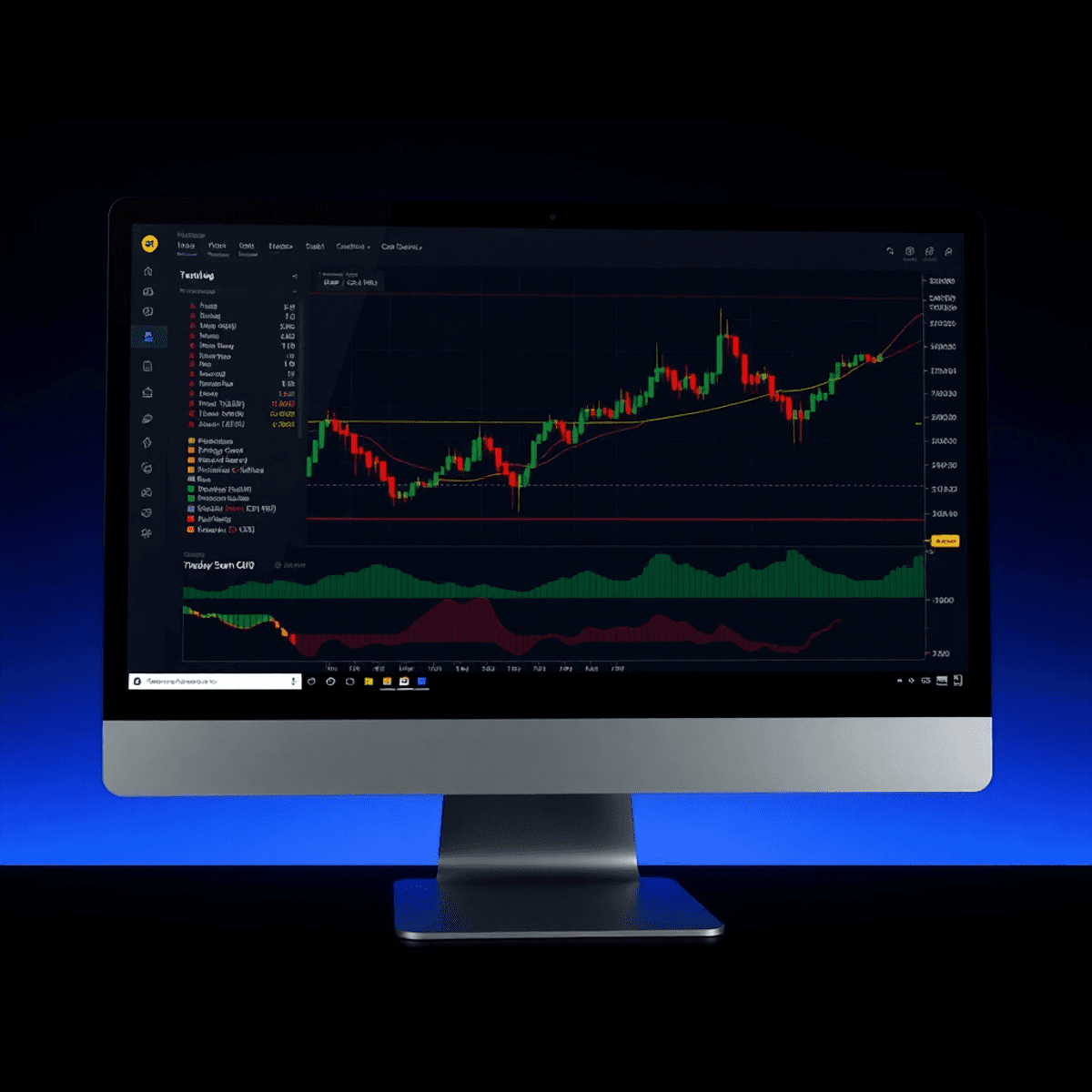Get -50% Off Today:
50OFF
:
:
Get -50% Off Today:

In today’s digital age, trading requires powerful analytical tools. That’s why Pine Script and TradingView built-ins are essential for technical analysis.
Pine Script is TradingView’s proprietary programming language that allows traders to create custom indicators and automated strategies. These custom scripts can be used in various contexts such as an automated crypto signal platform, or for developing forex strategies for tradingview.
TradingView built-ins are pre-coded functions and variables that make the development process easier. They save time by providing ready-made solutions for common tasks.
The ability to script custom indicators has become essential for traders seeking a competitive edge. With Pine Script, you can:
This programming capability transforms raw market data into actionable trading signals.
Understanding the relationship between Pine Script and its built-in functions helps you:
This comparison explores how Pine Script and TradingView built-ins work together, helping you make informed decisions about when to use each option in your trading toolkit.
Moreover, the integration of effective trading strategies on TradingView into your approach can significantly enhance your trading success. These strategies range from technical indicators to notable examples that can be implemented seamlessly with the help of TradingView’s alert setup for automated trading.
Lastly, if you’re looking to buy TradingView strategy signals, understanding these tools will provide you with a solid foundation to leverage them effectively.
Pine Script is the programming language used by TradingView. It was created for traders and analysts who want to build their own tools for technical analysis. Since its launch in 2013, Pine Script has grown into a powerful platform that is both easy to use and capable of advanced analysis.
Pine Script is great for creating custom indicators and automated trading strategies. With it, you can build everything from simple moving averages to intricate algorithmic trading systems. The language’s design allows for:
TradingView built-ins are pre-written functions and variables in Pine Script that make it easier to create your own trading tools. Think of them as the building blocks of your scripts.
Here’s an example of how you can use some built-in functions in Pine Script:
pine
//@version=5
study(“Example Built-ins”)
sma = ta.sma(close, 20) // Built-in Simple Moving Average
rsi = ta.rsi(close, 14) // Built-in RSI
In this snippet, we import two commonly used indicators: the Simple Moving Average (SMA) and the Relative Strength Index (RSI). By leveraging these built-ins, we can save time and effort by not having to manually code these calculations ourselves.
The vibrant Pine Script community plays a crucial role in enhancing the ecosystem. Many traders share their custom scripts publicly on TradingView’s library, fostering an environment where everyone can learn from each other and improve their skills.
Some examples of what you might find in this public library include:
In addition to built-ins specifically designed for technical analysis and strategy execution, Pine Script also offers several other namespaces that expand its capabilities further.
These additional namespaces include:
math.*: Contains mathematical functions like rounding or trigonometric operations.str.*: Provides string manipulation functions such as concatenation or substring extraction.array.*: Offers array manipulation functions allowing you to work with lists efficiently.By utilizing these extended functionalities alongside existing built-ins, you can perform specialized operations seamlessly within your scripts.
One of the standout features of Pine Script is its ability to automate trading processes through programmatic execution commands.
This means that instead of manually placing trades based on signals generated by your indicators or strategies, you can set up rules within your script that automatically execute buy/sell orders when certain conditions are met.
Such automation brings several advantages:
This capability becomes particularly useful when implementing automated Pine crypto services or developing specific stock strategies using the platform (learn more).
With these powerful features combined—customizability through user-defined scripts; efficiency via built-in functions; collaboration via community contributions; extensibility via additional namespaces; automation via programmatic execution—Pine Script offers an unparalleled toolkit for traders seeking to gain an edge in financial markets.
Built-in functions in Pine Script offer significant advantages when implementing common trading calculations. You’ll save substantial development time using pre-tested functions rather than writing custom code from scratch, which is often a more complex process, as discussed in this Pine Script tutorial. Here’s a practical example:
pinescript
//@version=5
myCustomMA(source, length) =>
sum = 0.0
for i = 0 to length – 1
sum := sum + source[i]
sum / length
pinescript
//@version=5
ta.sma(close, 20)
The built-in ta.sma() function:
Custom coding becomes valuable when you need specialized functionality beyond built-ins. Consider these scenarios:
In fact, you can explore the potential of custom scripts further by utilizing resources like Master Trading with Custom Scripts: A Guide to Pine Script, which can help you create custom indicator scripts and enhance your trading strategies.
Built-in functions handle resource management efficiently, particularly important given TradingView’s execution limits. Your custom code might require additional optimization to achieve similar performance levels, a challenge that can be mitigated by understanding the best practices in algorithmic trading programming languages as outlined in this article about the best programming language for algo trading.
pinescript
//@version=5
// Combining built-ins with custom logic
customRSI = ta.rsi(close, 14)
customSignal = customRSI > 70 ? “Overbought” : customRSI < 30 ? “Oversold” : “Neutral”
This hybrid approach leverages built-in efficiency while adding custom analysis layers. You’ll find this method particularly useful when developing sophisticated trading strategies that require both standard indicators and unique market perspectives.
TradingView’s namespaces are essential for Pine Script’s functionality, each serving distinct purposes in your trading analysis. Let’s explore the essential namespaces you’ll encounter:
syminfo.ticker – Returns the current symbol’s tickersyminfo.mintick – Provides the minimum price movementsyminfo.timezone – Accesses the symbol’s exchange timezonetimeframe.period – Shows current chart timeframetimeframe.multiplier – Reveals timeframe’s numeric valuetimeframe.isintraday – Checks if current timeframe is intradaybarstate.isconfirmed – Confirms if current bar is completedbarstate.isfirst – Identifies the first bar in the datasetbarstate.islast – Detects the most recent barstrategy.entry – Places entry ordersstrategy.exit – Manages exit positionsstrategy.close – Closes all open positionsThese namespaces work together seamlessly in your trading scripts. The syminfo namespace helps you build robust multi-market strategies, while timeframe enables adaptive analysis across different time periods. For instance, when developing buy/sell scripts for TradingView, you can leverage these namespaces to maximize your trading edge.
The barstate ensures accurate signal generation, which is critical when utilizing trading signals for more informed decision-making. Moreover, with the right combination of these namespaces, you can create sophisticated trading systems that incorporate technical analysis using indicators like SMA, RSI, and VWAP.
Additionally, these namespaces can also be adapted for specific scenarios such as crypto scalping strategies or trading strategies for sideways markets, allowing for consistent profits and effective risk management.
TradingView’s ta namespace houses a comprehensive collection of pre-built technical indicators designed for rapid strategy development. You’ll find essential tools like Moving Averages (SMA, EMA, WMA), momentum indicators (RSI, MACD), and volume-based indicators (OBV, CMF) ready for immediate implementation. These built-in indicators are among the best TradingView indicators for 2024 which can significantly enhance your trading strategies.
Here’s what you can achieve with built-in technical indicators:
Quick Strategy Prototyping
Reliable Backtesting Results
The reliable backtesting results provided by these built-in indicators make them an invaluable tool for traders.
The ta.sma() function exemplifies the power of built-ins:
pinescript
//@version=5
strategy(“SMA Crossover Strategy”)
fastMA = ta.sma(close, 10)
slowMA = ta.sma(close, 20)
Built-in indicators also support advanced trading concepts:
These pre-coded functions handle complex calculations while maintaining script performance. You can focus on strategy logic rather than implementing mathematical formulas from scratch.
The ta namespace enables sophisticated analysis through indicator combinations:
pinescript
rsiValue = ta.rsi(close, 14)
macdLine = ta.macd(close, 12, 26, 9)
Moreover, if you’re looking to explore more about Pine Script automation tools, there are numerous resources available that delve deeper into this subject.
TradingView’s cloud-based infrastructure imposes specific resource limits on Pine Script execution to maintain system stability and ensure fair usage across its user base. These constraints directly impact your script development and execution capabilities:
These limitations affect complex strategy development, particularly when working with multi-symbol analyses or sophisticated backtesting scenarios. You might need to optimize your code by:
To aid in overcoming these challenges, resources such as the Pine Script Course on TradingView can provide valuable insights. Additionally, the Pine Script Trading Strategies guide offers practical examples that can enhance your understanding and application of Pine Script.
The Pine Script Reference Manual serves as your primary resource for understanding these limitations and optimizing your code. The documentation provides:
TradingView’s documentation platform includes:
Pine Script™ User Manual: Essential concepts and syntaxPine Script™ Reference: Complete built-in function catalogPine Script™ FAQ: Common troubleshooting solutionsRegular updates to the Pine Script environment introduce new features and optimizations, making it essential to stay current with the latest documentation and release notes.
Creating efficient Pine Script code requires a strategic blend of custom functions and built-in utilities. Here’s how you can optimize your scripts:
ta.sma, ta.rsi)ta namespace first for technical indicatorsrequest.security for efficient multi-timeframe analysismath namespace functions for complex calculationsThese practices help create maintainable, efficient scripts that leverage TradingView’s robust built-in functionality while adding custom logic where needed. Your code becomes easier to debug, modify, and share with other traders in the community.
For a more comprehensive understanding of coding indicators in Pine Script, consider exploring this resource, which offers valuable insights and techniques.
The integration of Pine Script and TradingView built-ins creates a powerful synergy in trading analysis. Custom Pine Script development allows you to craft unique indicators tailored to your specific trading needs, while built-in functions provide reliable, tested components that streamline your coding process.
However, the true strength lies in mastering both elements:
For instance, understanding how to determine optimal exit points can significantly enhance your trading strategy by minimizing losses and maximizing profits. Furthermore, leveraging verified trading signals can boost your decision-making process and overall trading success.
You’ll find your trading analysis reaches new heights when you harness both Pine Script’s flexibility and TradingView’s built-in functions. Start with built-ins to understand core concepts, then gradually incorporate custom Pine Script elements to create sophisticated trading tools.
A practical application of this dual approach could be seen in our Versatile Bollinger Band Cascade, an advanced trading system designed to elevate your trading experience. Unlike traditional Bollinger Bands strategies, this one integrates unique features and customization options for a more personalized approach.
The path to advanced trading analysis begins with embracing both Pine Script’s creative freedom and TradingView’s built-in efficiency. This dual strategy not only helps build robust, personalized trading systems but also paves the way for high-profit trading strategies.
Pine Script is TradingView’s proprietary programming language designed for creating custom trading indicators and strategies. TradingView built-ins are pre-defined functions and variables within Pine Script that provide ready-to-use technical analysis tools, enhancing scripting efficiency.
Using built-in functions in Pine Script reduces coding time and errors by leveraging optimized, pre-coded calculations for common technical indicators. Custom scripts, however, allow traders to extend functionality beyond built-ins, tailoring strategies to specific needs.
Namespaces in TradingView’s ecosystem organize functions and variables by purpose: the ‘ta’ namespace offers technical analysis indicators; ‘syminfo’ provides symbol-related information essential for multi-symbol scripts; and ‘strategy’ manages trading logic and backtesting features.
TradingView imposes cloud-based execution limits on Pine Script such as script size, memory usage, data requests, and execution time to ensure fair use. These constraints can impact the complexity of strategies or multi-symbol analyses developers can implement.
Best practices include blending robust built-in utilities with custom code to maximize efficiency while maintaining readability and performance. Avoid redundancy by utilizing existing functions wisely and optimize script structure for faster execution.
Official TradingView documentation serves as a comprehensive resource for mastering Pine Script syntax and understanding built-in functions and variables. Additionally, community contributions and forums provide practical insights for developing advanced trading strategies.
 pineindicators.com
pineindicators.com

Wait! Before your leave, don’t forget to…
OR copy the website URL and share it manually:
https://pineindicators.com/free